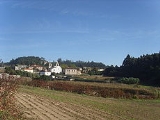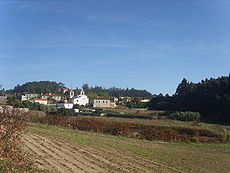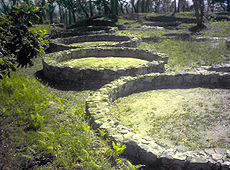
Terroso
Encyclopedia


Portugal
Portugal , officially the Portuguese Republic is a country situated in southwestern Europe on the Iberian Peninsula. Portugal is the westernmost country of Europe, and is bordered by the Atlantic Ocean to the West and South and by Spain to the North and East. The Atlantic archipelagos of the...
parish located in the municipality of Póvoa de Varzim
Póvoa de Varzim
Póvoa de Varzim is a Portuguese city in the Norte Region and sub-region of Greater Porto, with a 2011 estimated population of 63,364. According to the 2001 census, there were 63,470 inhabitants with 42,396 living in the city proper. The urban area expanded, southwards, to Vila do Conde, and there...
. In the census of 2001, it had a population of 2,472 inhabitants and a total area of 4.63 km².
Terroso derives from the Latin Terrosu meaning full of soil as a reference to Cividade
Cividade de Terroso
Cividade de Terroso was an important city of the Castro culture in North-western Iberian Peninsula, located in Póvoa de Varzim, Portugal.The city, known in the Middle Ages as Civitas Teroso, was built at the top of Cividade Hill, in the parish of Terroso, in Póvoa de Varzim, less than 5 km...
or Cividade Hill
Cividade Hill
thumb|200px|The hilltop. Entrance of [[Cividade de Terroso]].Cividade Hill is one of the two hills next to the city of Póvoa de Varzim in Portugal...
.
History
Cividade de TerrosoCividade de Terroso
Cividade de Terroso was an important city of the Castro culture in North-western Iberian Peninsula, located in Póvoa de Varzim, Portugal.The city, known in the Middle Ages as Civitas Teroso, was built at the top of Cividade Hill, in the parish of Terroso, in Póvoa de Varzim, less than 5 km...
, an ancient Castro city established around 900 and 800 BC is located in the parish of Terroso. But the parish has been shaped by man since much earlier times. Tumuli are known to exist in the area: such as in Leira da Anta and Cortinha da Fonte da Mama, one of which: Mamoa de Sejães still exists unbroken after thousands of years.
The earliest reference to Terroso dates from 953: subtus montis Terroso, referring to its hill.
The remains of a castle tower built in the 13th and 14th centuries can still be found in the Hamlet of Paço.
The Parish Church was built in the first half of the 16th century. It was erected under the orders of King D. Manuel I. It went through several alterations over the centuries that have changed the original design. The latest involved the building of a second tower with a small carillon. The best piece is a 16th century Statue of the Virgin with legendary origins, probably an Italian work.
A Chapel dedicated to Saint Savior (São Salvador) was built in the Hamlet that took its name. It contains a proto- baroque altar with a painting depicting the miracle of the Battle of Ourique. Also from the 17th century there is a small structure that marks the beginning of the aqueduct. It has 4 columns of the Tuscan order holding a small tile roof. It houses a polychromous statue of St Anthony.
The Hamlet of Santo António takes its name from a large baroque Chapel dedicated to St. Anthony. The interior of the chapel has some good quality golden gilded carved wood altars.
It was under the administration of Barcelos
Barcelos, Portugal
Barcelos is a city in Barcelos Municipality in Braga District. The city has a population of 20,625.-History:Originally a Roman settlement, it expanded and became the seat of the First Duke of Bragança in the 15th century...
city council, until it was transferred to the municipality of Póvoa de Varzim in 1836.
Geography
Terroso is located 5 km north of downtown Póvoa de Varzim; and is bordered by NavaisNavais
Navais is a Portuguese parish, located in the municipality of Póvoa de Varzim. In the census of 2001, it had a population of 1,683 inhabitants and a total area of 4.23 km².-History:...
and Estela
Estela
Estela is a Portuguese parish, located in the municipality of Póvoa de Varzim. In the census of 2001, it had a population of 2,596 inhabitants and a total area of 11.73 km²....
to the nort; Laundos
Laundos
Laundos or Laúndos is a Portuguese parish, located in the municipality of Póvoa de Varzim. In the census of 2001, it had a population of 2,131 inhabitants and a total area of 9.69 km²....
and the municipality of Vila do Conde to the east; Amorim
Amorim
Amorim is a Portuguese surname. A habitational name from any of the various places named Amorim, originally Amorini, from the name of the estate owner.It may refer to:- People :*Ana Amorim, Brazilian handball player...
to the west and Beiriz
Beiriz
Beiriz is a Portuguese parish, located in the municipality of Póvoa de Varzim. In the census of 2001, it had a population of 3,229 inhabitants and a total area of 4.31 km².Beiriz is known for its Tapetes de Beiriz .-History:...
to the south. Most of the parish is crowned by Cividade Hill and it extends to São Lourenço plain.
Cividade Hill was known by its pure waters, thus an aqueduct was raised in the 17th century, taking its waters to Santa Clara Convent in Vila do Conde.
Hamlets
The parish is divided into 15 hamlets:- São Lourenço
- Carregal
- PassôPassôPassô is a Portuguese hamlet located in the parish of Terroso, Póvoa de Varzim....
- Santo António
- Paço
- Póvoas
- São Pedro
- São Salvador
- Paranho
- Vilar
- Boavista
- Sejães
- Certainha
- Ordem
- Pé do Monte

